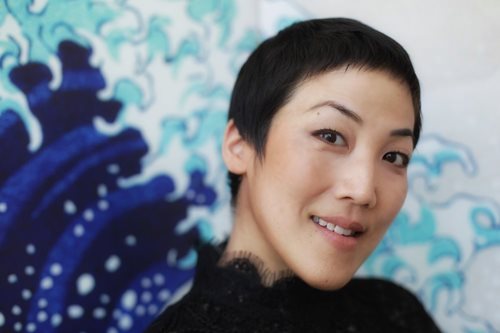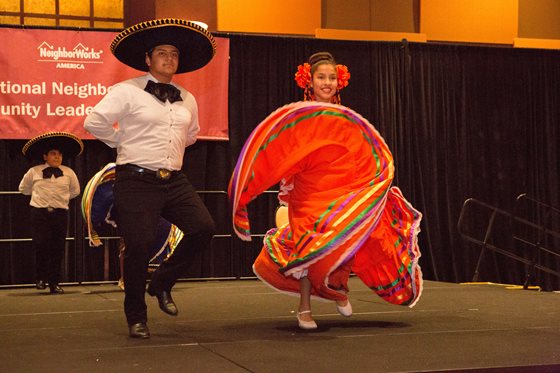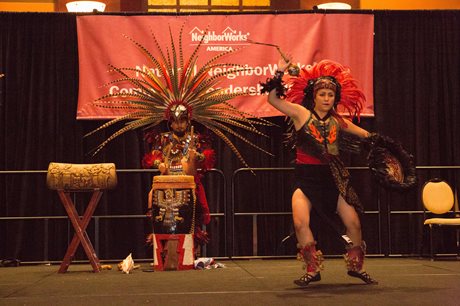What are the most effective ways to identify artists who can be good partners with us locally? And how do we work together so the relationship is successful and mutually beneficial? Those are two of the most common questions/challenges posed by network members when NeighborWorks America leveraged funding from The Kresge Foundation to explore how local nonprofits are using/want to use creative community development—defined as “the use of art and culture to facilitate positive social, physical and economic changes in neighborhoods, towns, tribal lands or regions.”
NeighborWorks America spent the last year researching this space and is beginning to incorporate artists and arts organizations into its own work. In this post, several team members and one of the artists with whom we have extensively engaged share their observations about the benefits, challenges and lessons learned.
Roles artists can play
 Traci Kato-Kiriyama, who has consulted with NeighborWorks America for the past year or so, is a well-known Asian-American artist in the Los Angeles area, but she also is described by her fans as “a visionary, teacher, bridge, mentor, activist, organizer, encourager and muse.” And her “coworkers” at NeighborWorks agree she is all of these things, creating communities that bring people together as learners and participants.
Traci Kato-Kiriyama, who has consulted with NeighborWorks America for the past year or so, is a well-known Asian-American artist in the Los Angeles area, but she also is described by her fans as “a visionary, teacher, bridge, mentor, activist, organizer, encourager and muse.” And her “coworkers” at NeighborWorks agree she is all of these things, creating communities that bring people together as learners and participants.“A lot of people view artists as people from whom you commission or purchase a product, a work of art,” notes Kato-Kiriyama. “While there is definitely a need and a role for that, what also is valuable is the artist’s way of thinking and approaching an issue or challenge, often by engaging members of the community. Our brains are wired to think a little bit differently. What too often happens, though, is that an organization notices a problem like low resident engagement, organizes an activity like a festival and brings in artists to perform. But artists can offer so much more than an end product when addressing community engagement or tough situations in the neighborhood. ‘Art’ can be a community practice, a way in which we dive into an issue and collaborate through transformative processes. From a collective songwriting workshop to a community-sustaining arts space, I’ve had the pleasure of witnessing and being a part of deeply groundbreaking practices.”
Amber Trout, NeighborWorks’ director of equity and inclusion initiatives, agrees.
 “The way artists approach our work is just different from our usual perspective,” observes Trout, who first collaborated with Kato-Kiriyama on a NeighborWorks Training Institute (NTI) symposium. “For example, Traci thinks about it from the participants’ lens, alternating between the head, the heart and then the head again. She helped me see and consider different ways to present material and what other voices needed to be incorporated and nurtured. Working with Traci in that broader capacity, not just as a performer but as a ‘co-creator,’ was really rather transformative for me and how I do my own work.”
“The way artists approach our work is just different from our usual perspective,” observes Trout, who first collaborated with Kato-Kiriyama on a NeighborWorks Training Institute (NTI) symposium. “For example, Traci thinks about it from the participants’ lens, alternating between the head, the heart and then the head again. She helped me see and consider different ways to present material and what other voices needed to be incorporated and nurtured. Working with Traci in that broader capacity, not just as a performer but as a ‘co-creator,’ was really rather transformative for me and how I do my own work.”In addition to the more traditional role of personally performing, which she has done at several NTIs and the Community Leadership Institute, Kato-Kiriyama has helped lead brainstorming sessions, conceptualize themes, re-imagine agendas and explore alternative approaches to presenting different types of content.
"She helped me see and consider different ways to present material and what other voices needed to be incorporated and nurtured."
“That was a surprise to me,” notes Trout. “Traci isn’t focused on her own performance time and space. She sees us all as performers when we moderate, speak or are just present.”Angela Carlberg, a senior manager in NeighborWorks’ training division, adds to that concept of “just being present,” noting that “Traci is very good about pulling us out of our rigid structures, our ‘this-is-how-we-do-it’ mindset. She encourages us to pause and build in room for reflection, both during the process of planning an event and then on the actual day. She challenged us to create room to do that silently as an individual, or in community with others, in a variety of ways.”
An example cited by Carlberg is the Philadelphia NTI symposium in August 2017. “We spent a lot of time planning the day as well as my own remarks in the morning,” she recalls. “But then, [the violence in] Charlottesville happened. We had some very long conversations around how to name the impact it had on myself and my immediate community. Traci helped me think that through: Yes, we're going on with the day as planned, but we also need to make space to be honest about how the protest and attacks resonated with people in the room. The unexpected benefit was that it allowed me to show up as myself, be vulnerable and be in community.”
Finding the right artist
The ‘right artist’ depends on what role you want an artist to play. No matter what the purpose, however, Kato-Kiriyama encourages organizations to first look locally. “Look very deeply into your communities,” she advises, adding that when organizations are interested in finding a person who can play the broader type of role she has filled for NeighborWorks, they should look for artists who already are teaching, facilitating workshops with youth or seniors, or collaborating with residents in other ways.
“Look very deeply into your communities,” she advises, adding that when organizations are interested in finding a person who can play the broader type of role she has filled for NeighborWorks, they should look for artists who already are teaching, facilitating workshops with youth or seniors, or collaborating with residents in other ways.Carlberg agrees. “You need to make sure you’re aware of your individual biases regarding what art is. If you only think about art in terms of a product, you might not see the art that a community produces. For example, if your town has arts programming for kids, there is an artist there.”
Trout first connected with Kato-Kiriyama when Dean Matsubayashi, a member of NeighborWorks’ Race, Equity, Diversity and Inclusion (REDI) initiative from Little Tokyo Service Center, mentioned the artist. She is the founder of the longest-running open-mic night in the Los Angeles community.
“It was the community who pointed us to Traci,” observes Trout. “And in turn, she has connected us to other artists. Pretty soon, you unleash a network.”
Tips for partnering effectively
Pay competitively. “What I've learned is our community usually lowballs artists,” explains Trout. “But they are professionals just like everyone else, and if you do your procurement research, you’ll see there is some standard pricing. If we are serious about infusing arts and creativity into our work, then we also have to be serious about allowing artists to earn a livable income.”Carlberg also emphasizes the importance of treating artists in the local community the same as those brought in from the outside.
“There are clear disparities in the rates paid to artists in the community vs. those who come in,” Carlberg explains. “But community-level knowledge and engagement offer significant benefits and honoraria should be consistent. We need to be aware of the role we play in influencing or mitigating such disparities.”
Be open to doing things differently. Kato-Kiriyama says she too often hears, “This is how it's always been done.” She is particularly excited about the Dec. 5 symposium at the Pittsburgh NTI because the usual structure is relaxed, allowing room to try new things, including a conversation session patterned on the world café model, called “Community Voices: Living Out Loud.”
Get out of the way. “We reach out to artists because they work with the community in unique ways, so let them do what they do best. Don’t try to force the work in a pre-determined direction. Get out of the way a little bit and allow the creative process to unfold,” advises Carlberg.

